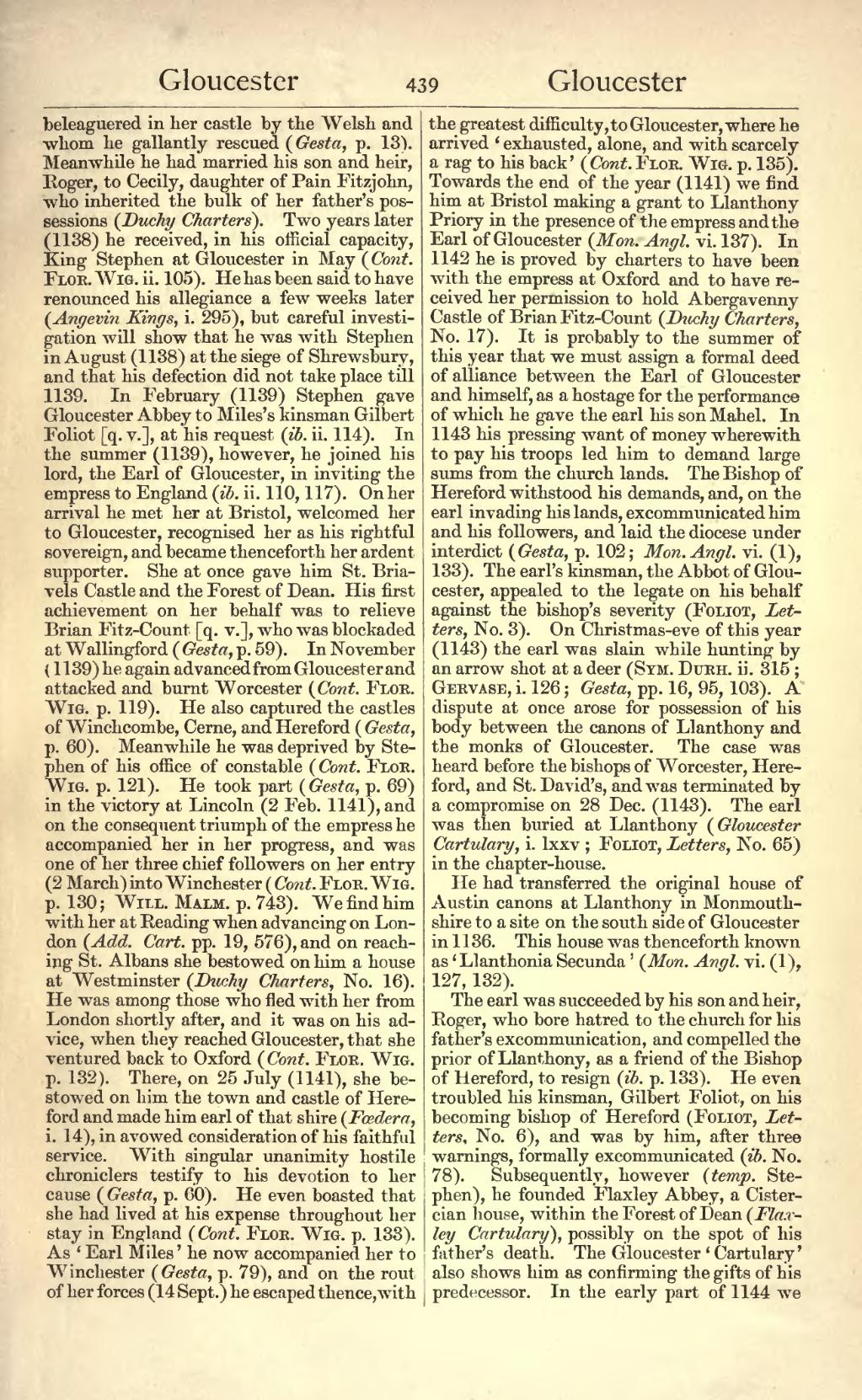beleaguered in her castle by the Welsh and whom he gallantly rescued (Gesta, p. 13). Meanwhile he had married his son and heir, Roger, to Cecily, daughter of Pain Fitzjohn, who inherited the bulk of her father's possessions (Duchy Charters). Two years later (1138) he received, in his official capacity, King Stephen at Gloucester in May (Cont. Flor. Wig. ii. 105). He has been said to have renounced his allegiance a few weeks later (Angevin Kings, i. 295), but careful investigation will show that he was with Stephen in August (1138) at the siege of Shrewsbury, and that his defection did not take place till 1139. In February (1139) Stephen gave Gloucester Abbey to Miles's kinsman Gilbert Foliot [q. v.] at his request (ib. ii. 114). In the summer (1139), however, he joined his lord, the Earl of Gloucester, in inviting the empress to England (ib. ii. 110, 117). On her arrival he met her at Bristol, welcomed her to Gloucester, recognised her as his rightful sovereign, and became thenceforth her ardent supporter. She at once gave him St. Briavels Castle and the Forest of Dean. His first achievement on her behalf was to relieve Brian Fitz-Count [q. v.] who was blockaded at Wallingford (Gesta, p. 59). In November (1139) he again advanced from Gloucester and attacked and burnt Worcester (Cont. Flor. Wig. p. 119). He also captured the castles of Winchcombe, Cerne, and Hereford (Gesta, p. 60). Meanwhile he was deprived by Stephen of his office of constable (Cont. Flor. Wig. p. 121). He took part (Gesta, p. 69) in the victory at Lincoln (2 Feb. 1141), and on the consequent triumph of the empress he accompanied her in her progress, and was one of her three chief followers on her entry (2 March) into Winchester (Cont. Flor. Wig. p. 130; Will. Malm. p. 743). We find him with her at Reading when advancing on London (Add. Cart. pp. 19, 576), and on reaching St. Albans she bestowed on him a house at Westminster (Duchy Charters, No. 16). He was among those who fled with her from London shortly after, and it was on his advice, when they reached Gloucester, that she ventured back to Oxford (Cont. Flor. Wig. p. 132). There, on 25 July (1141), she bestowed on him the town and castle of Hereford and made him earl of that shire (Fœdera, i. 14), in avowed consideration of his faithful service. With singular unanimity hostile chroniclers testify to his devotion to her cause (Gesta, p. 60). He even boasted that she had lived at his expense throughout her stay in England (Cont. Flor. Wig. p. 133). As ‘Earl Miles’ he now accompanied her to Winchester (Gesta, p. 79), and on the rout of her forces (14 Sept.) he escaped thence, with the greatest difficulty, to Gloucester, where he arrived ‘exhausted, alone, and with scarcely a rag to his back’ (Cont. Flor. Wig. p. 135). Towards the end of the year (1141) we find him at Bristol making a grant to Llanthony Priory in the presence of the empress and the Earl of Gloucester (Mon. Angl. vi. 137). In 1142 he is proved by charters to have been with the empress at Oxford and to have received her permission to hold Abergavenny Castle of Brian Fitz-Count (Duchy Charters, No. 17). It is probably to the summer of this year that we must assign a formal deed of alliance between the Earl of Gloucester and himself, as a hostage for the performance of which he gave the earl his son Mahel. In 1143 his pressing want of money wherewith to pay his troops led him to demand large sums from the church lands. The Bishop of Hereford withstood his demands, and, on the earl invading his lands, excommunicated him and his followers, and laid the diocese under interdict (Gesta, p. 102; Mon. Angl. vi. (1), 133). The earl's kinsman, the Abbot of Gloucester, appealed to the legate on his behalf against the bishop's severity (Foliot, Letters, No. 3). On Christmas-eve of this year (1143) the earl was slain while hunting by an arrow shot at a deer (Sym. Durh. ii. 315; Gervase, i. 126; Gesta, pp. 16, 95, 103). A dispute at once arose for possession of his body between the canons of Llanthony and the monks of Gloucester. The case was heard before the bishops of Worcester, Hereford, and St. David's, and was terminated by a compromise on 28 Dec. (1143). The earl was then buried at Llanthony (Gloucester Cartulary, i. lxxv; Foliot, Letters, No. 65) in the chapter-house.
He had transferred the original house of Austin canons at Llanthony in Monmouthshire to a site on the south side of Gloucester in 1136. This house was thenceforth known as ‘Llanthonia Secunda’ (Mon. Angl. vi. (1), 127, 132).
The earl was succeeded by his son and heir, Roger, who bore hatred to the church for his father's excommunication, and compelled the prior of Llanthony, as a friend of the Bishop of Hereford, to resign (ib. p. 133). He even troubled his kinsman, Gilbert Foliot, on his becoming bishop of Hereford (Foliot, Letters, No. 6), and was by him, after three warnings, formally excommunicated (ib. No. 78). Subsequently, however (temp. Stephen), he founded Flaxley Abbey, a Cistercian house, within the Forest of Dean (Flaxley Cartulary), possibly on the spot of his father's death. The Gloucester ‘Cartulary’ also shows him as confirming the gifts of his predecessor. In the early part of 1144 we
